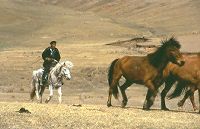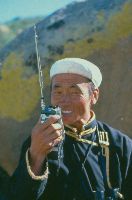The ultimate goal of the Reintroduction Project is to establish a self-supporting sustainable population of at least 500 Przewalski horses at Hustai National Park.
Protection
Why an everlasting protection of the Przewalski horses at Hustai National Park? Foremost, they form a highly endangered species of which there are about 2,000 left in the whole world.
 Cross-breeding with domestic Mongolian horses is areal threat. Hybridisation causes the loss of the wild horse’s unique genetic qualities. For instance, Przewalski horses have 66 chromosomes, domestic horses and hybrids 64.
Cross-breeding with domestic Mongolian horses is areal threat. Hybridisation causes the loss of the wild horse’s unique genetic qualities. For instance, Przewalski horses have 66 chromosomes, domestic horses and hybrids 64.
Wherever water is found there will be nomads and their herds of livestock. Cattle, goats and sheep are well tended, but camels and horses wander unguarded over the steppe, often covering large distances. In their search for grass and water they might pass the boundaries of the protected Hustai National Park. It is the task of the rangers and wardens to oust the intruders.
There is very little chance that crossbreeding will ever occur among the members of a harem, because the leading stallions act very hostile toward domestic horses.
The roaming bachelor stallions are more likely to interbreed with unguided domestic mares. This has to be expected with the future growth of the Przewalski population. In consultation with the local authorities and the herdsmen the traditional yearly returning ‘otors’ were revived. From October till March hired hands take care of all domestic horses in the area. Hundreds of horses are at once being driven to greener areas in order to spare the local grasslands. The reintroduction of the otor has the advantage that no domestic horse will enter into the area reserved for the Przewalski horses during the autumn and winter. Hopefully the continuation of organization of otors keeps going.
Management focused research activities
Little is known about the life of Przewalski horses before their disappearance from the wild in south-west Mongolia. Systematic studies will afford vital insight in the adaptation process from captivity to the wild, the development of the population with its social structures, spatial distribution and daily habits.
Habitat use
Each group of freely roaming Przewalski horses has its own home range, the area through which a group daily migrates in search of food, water, minerals and shelter. The size of a home range differs seasonally. As there will be more groups freely roaming the area there will also be more overlap between the different home ranges.
 Since 1994 rangers, biologists, students and ecovolunteers have been involved in mapping the home ranges. A number of times a week the exact whereabouts of the Przewalski horses, along with their behaviour and the weather conditions of the moment are registered and entered in the computer. A dedicated piece of software ArcView (Geographical Information System) contains maps on Hustai’s water-balance, vegetation, soil, etc. The obtained data on the Przewalski horses is integrated in those maps and renders an insight in the daily movement of the horses according to the time of season.
Since 1994 rangers, biologists, students and ecovolunteers have been involved in mapping the home ranges. A number of times a week the exact whereabouts of the Przewalski horses, along with their behaviour and the weather conditions of the moment are registered and entered in the computer. A dedicated piece of software ArcView (Geographical Information System) contains maps on Hustai’s water-balance, vegetation, soil, etc. The obtained data on the Przewalski horses is integrated in those maps and renders an insight in the daily movement of the horses according to the time of season.
Carrying capacity
Obviously Hustai National Park is fit to provide all of its hoofed animals with sufficient nourishment. This implicates that not food, but home-range-size is the most determining parameter to estimate the area’s carrying capacity with regard to its growing population of Przewalski horses. On the basis of thoroughly executed research Hustai National Park evidentially has the capacity for at least 500 Przewalski horses.
Population dynamics
The demographic constitution of each group is measured a couple of times every week. Every mutation (birth, death, newcomers and the dispersal of youngsters) is registered. This is very helpful information for obtaining an insight in the social organisation, demographics and dynamics of the population. However, with the expected growth of the population it will surely get much more difficult to recognise individuals. In case of doubt the identity will be determined on basis of dung samples and DNA analysis. All genetic data from the 84 Przewalski horses that were introduced from the Netherlands into Hustai National Park is stored in the Van Haeringen Laboratories (Wageningen) in the Netherlands.
Health observation
Each season the project’s biologist keeps score of the physical condition of every individual Przewalski horse.
Each year Hustai’s biologists compose a report about experiences and discuss them with Mongolian experts in the Scientific Advice Council of Hustai National Park.
Additional data on food preference and social behaviour of the Przewalski horses is derived from the work by guest researchers and students from Mongolia and abroad. In 1998 the Jan-Bouman-Scholarship was instituted to give postgraduate Mongolian biology students the opportunity to take part in the research activities at Hustai National Park.
